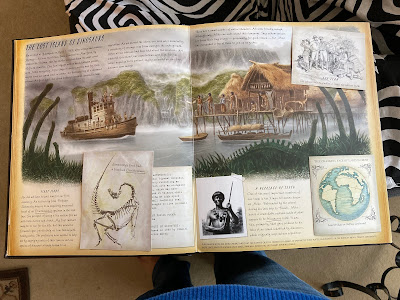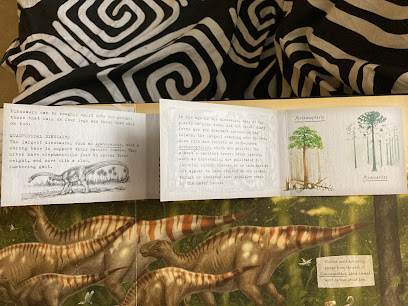Dinosaurology review
While I wait for my unfairly-delayed visit to the ROM, I convinced my father to visit my local library, the first time in by my estimate a year and a half. I admit with embarrassment I flocked to the kids' section eventually, as I always have since I was young. It was there I saw a book on the shelf that caught my attention and after being checked out: 2013's Dinosaurology: The Search for a Lost World*.
* Technically its Being an Account of an Expedition Into the Unknown South America -- April 1907, but I am not writing that subtitle nor saying that aloud
The book itself is part of the larger Ology series that's been going on since 2003, each professing to be a lost work about a particular subject, ranging from real and providing info (Oceanology, Knightology, and Spyology) to the fantastical (Monsterology, Alienology, and Dragonology), and written by a fictional author, although in truth they're all mostly done by authors like Dugald Steer, and overall a big part of my childhood.
Dinosaurology is supposedly the journal of one Raleigh Rimes, an apparent assistant prof. to the real life Percy Fawcett, who in this world discovered and mounted an expedition in 1907 to an island off the coast of South America called Yannapalu where non-avian dinosaurs (andothermesozoiclife) still roam. If you think this is like Arthur Conan Doyle's seminal story The Lost World.... well, just you see. Also, Dougal Dixon is the book's consultant. Who is he, my post-2000 readers ask? Well, he is a scottish scientist who has written many a book on dinosaurs and evolution throughout the 80's and 90's and still does, but also is one of the father of Speculative Evolution though his After Man series. Nice seeing him here. Meanwhile, the journal was supposedly in the collection of the British Association of Intrepid Explorers but is now being purged and reproduced by the publisher.
We'll review Dinosaurology spread by spread/page by page.
The first pages right after you flip open the book, actually a preface (is that the right word?), sets the basics up: Fawcett learnt of Yannapalu through a native boy in the Amazon and has organised an expedition there. Meanwhile, we see pictures of cave paintings of humans alongside dinosaurs that would make creationists drool, as well as a section on how the Chinese were among the first to discover fossils of dinosaurs.
The second spread introduces the characters and the setting as the expedition arrives on Yannapalu by boat. The characters in question are Rimes, Fawcett, son Jack Fawcett, geologist Edward Summersby, artist Helen Malone, Chinese palaeontologist Yang Wu, pet dog Roxton, and Xingu Native American translator Miko, the boy mentioned earlier. They see both an Ornithomimus skeleton in the rock and a human native village (and even a live ornie too, but Raleigh isn't sure of it at first). An inset booklet details the geological theories of the time for how creatures got places, with one being land bridges and the other being drifting plates. Since this is the 1900's (the decade), its ambiguous, but a publisher's note explains that the latter theory is now understood as the true one. This is actually something that shall occur throughout the book.
The next spread sees the team enter a floodplain where they see a whole herd of dinosaurs: Triceratops, Maisaura, and... an unknown theropod dinosaur like an ostrich, but even if you don't follow the asterisks to the publisher's not at the bottom, you can tell they are Ornithomimus relative and Jurassic Park star Gallimimus, only for an Allosaurus to show up and recreate the Gallis' scene in said movie.
After a map spread and flaps that highlight the island's environments and auxiliary info, the next pages detail a Triceratops fight. It's a pretty cool scene, with dust at their feet help conveying motion and weight, and the two have a fetching red colour scheme with golden yellow frills.
As the expedition treks through the forest and though the next spreads, they encounter all kinds of the dinosaurs: a herd of Iguanodon and a flock of Compsognathus, a close encounter with a Tyrannosaurus, a herd of Brachiosaurus menaced by a pack of raptors, and observing Diplodocus from a treetop settlement. They even spot other dinosaurs not known at the time, like Microraptor, Nothronychus, Suchomimus, and Gigantoraptor, not even get into the myriad of dead specimens they find. All the while, we get more booklets that provide info about dinosaurs and the mesozoic are provided, such as locomotion, plant life, eggs, . You also have a few humorous stuff too, like how to lure dinosaurs into traps or how to escape a predator. There's also a bit where they collect diamonds (remember that).
 |
| Excuse the finger |
There's a break from dinosaurs proper within two spreads to focus on other creatures of the mesozoic: the first is by a lagoon where our expedition sight various sea creatures, such as liopleurodon (with a correct length of 20 feet/6 m), ichthyosaurs, and mosasaurs, and Elasmosaurus (which looks suspiciously like Lake Serpents in the same series' Monsterology.... *Thinking emoji*), as well as unknown fish and giant crocodile that we know as Coelocanth and Sarcosuchus respectively. There's even a bit where the infamous giant shark [Otodus] Megalodon's jaw bones are reconstructed.
The next, on the cliffs of the island, sees the team bring out gliders they were apparently carrying all this time to soar with pterosaurs, such as Pteranodon, Pterodaustro, Ramphorynchus, and Hatzegopteryx (all except the formermost unidentified bar the Publisher's note at the bottom). The Pteranodon we see aren't exactly the most pretty. I do like the designs on the right, though. Pretty nice, especially with the bird-inspired colouration is. The Hatzeg is also fine for its time.
The team observes billowing smoke from a volcano which worries them as they head up the dormant volcano at the center of Yannapalu, observing at the same time a pack of Velociraptors about to hunt a herd of Parasaurolophus. However, they can't stay for long.
In the caves of the volcano, the team observe carvings on the walls made by the natives. However, they are interrupted by both a battle between a Euoplocephalus (sorry, Stereocephalus) and the Hatzegopteryx. Tremors and the release of volcanic smoke soon come.
The penultimate spread of the book sees the crew observe the natives perform a sacrifice at a bonebed of dinosaur corpses to appease a volcano god, who looks suspiciously like how aztecs might draw a pterosaur (and the above mentioned fight was seen as an omen). At the same time do manage to sight an Archeopteryx to their excitement. But the rumblings continue, and because of this, the expedition has to leave Yannapalu, hoping to return someday.
The book ends with a sombre note, where its revealed in the 1930's the geologic activity only hinted at the end sunk the island, taking the dinosaurs with them. Oh, and Arthur Conan Doyle stole the idea and published it as merely fiction against Fawcett's wishes. All that are left are the diamonds collected earlier.
As usual for the series, the fun comes from the simulacrum of old books and the brilliant artwork. Its all very simple yet detailed and alive, with several styles in the book from different artists. You also have insets and booklets which provide addition information. It's all done in a handmade journal style, complete with illustrations of tape fastening notes to the journal's pages.
As you may have noticed, Dinosaurology features several species of fossil life not known from the year 1907, but rather then bullshitting readers (even young ones) and just have the characters name drop them, they're merely referred to as unknown species that bewilder the expedition, especially the feathered ones. It's the most interesting creative choice in the book.
The information in the book consists of the general basics of the mesozoic and dinosaurs with a few detours to other topics, like lovomotion, fossils, and plant life. You also have brief profiles of historic palaeontologists and their most famous finds (like Othniel Charles Marsh and Edward Drinker Cope and the Bone Wars and the Rev. William Buckland and the first named dinosaur, megalosaurus), which are nice touch.
I also love the twist of how the story directly inspired AC Doyle's Lost World in-universe too.
Now onto what I don't like about Dinosaurology.
Even though the book is barely a decade old and itself notes how science has marched on, a lot can change in just 8 years. Naturally, the majormost one has to do with feathers: most of the dinosaurs that should have feathers, the coelurosaurs and maniraptors lack them or don't have enough. There are also the usual suspects: pronated hands, elephant-footed sauropods and ceratopsids with visible toes, pterosaurs that generally lack filaments, and plesiosaurs and mosasaurs without flukes.
Another big problem is that due to having multiple artists each applying a different style, the book tends to have inconsistent designs for each dinosaurs, even on the same page as each other. Some are more cartoonish, some are more realistic, and others just look plain ugly. That's not always a good thing, as it can be distracting and confusing.
While it is commendable it does take efforts to acknowledge that many dinosaurs we 21st century audience know perfectly well aren't known to the very early 1900's characters, it's inconsistent: For instance, Velociraptor is identified by name even though it wouldn't be named until 1924.
At one point a baby Ornithomimus latches onto Helen.... but it's never seen again in the book. I don't know if it was meant to be the pet of the team alongside the dog Roxton, but it never aoppears afterward even though something tells me this was the intention (at least that's what I got from reading it unless i'm mistaken) and I wish there was more of it.
One final, minor note of criticism is that the dinosaur that will be Nothronychus is described as looking like a tyrannosaur. Right, because the long neck and huge arms and claws totally make it resemble the short necked and armed tyrants.
Honestly, if I were the one writing it, I'd slip in a few more references to other Ology series when appropriate as fun easter eggs for readers. Also, it'd correct the taxon name problem seen in the book, as well as add a few more fauna from the southern hemisphere since its off the coast of South America.
But still, in spite of not exactly being a must read, Dinosaurology a great little book for what it is.
- Accuracy - 7/10
- Aging - 6/10
- Presentation - 8/10
- Art - 8/10
- Storytelling - 7/10
- Rereadability - 7/10
Goodbye for now!




















Comments
Post a Comment